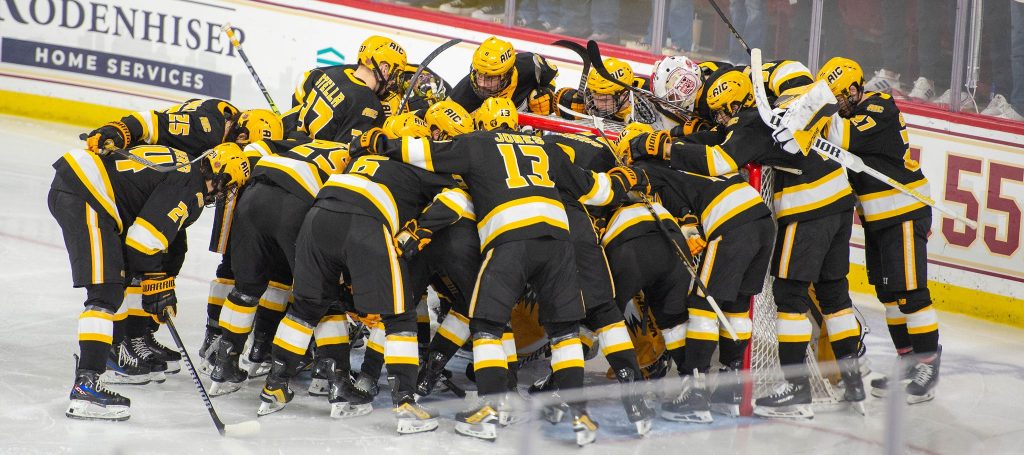
Each week during the season, we look at the big events and big games around Division I men’s college hockey in Tuesday Morning Quarterback.
Ed: Jim, last Wednesday when we spoke with College Hockey Inc. executive director Sean Hogan on the USCHO Spotlight podcast, he noted that there’s been more change in college hockey in the last 12 to 18 months than in the previous 15 or 20 years.
Many of them seem destined to work against smaller schools or smaller budgets. We’ve expressed concern in “print” and on our podcasts that we might lose some schools at a time when there’s more of a need for Division I hockey programs than ever before.
After TMQ was published last week, word came unexpectedly that American International College was going to drop its men’s hockey program to D-II. We’re going to address a number of aspects to the decision, including how it affects students, staff and their families, and the entire D-I landscape.
But first I’d like to comment on how it was handled by the college. On Wednesday, AIC announced its “Pathway to Progress” plan, addressing enrollment and budget issues, and specifically how athletics would be affected. Men’s wrestling and women’s tennis will be dropped entirely.
The news release outlining the plans included some FAQs, including this one about hockey:
“How will the College handle funds that have been donated to men’s ice hockey?
“Funds raised for the men’s ice hockey program will continue to be utilized to support the ice hockey program, allowing it to be competitively positioned among peers and offering a greater level of impact than if the program were to stay in Division I.”
If I can quote a somewhat coarse phrase, “Don’t pee on my leg and tell me it’s raining.” It’s hard to see how there could be any bigger impact to AIC as an institution than to have a national brand on the highest level of D-I athletics.
Before the No. 16 seed Yellow Jackets upset No. 1 St. Cloud in the 2019 NCAA regionals, American International wasn’t exactly a household name. But a stretch of success in Atlantic Hockey and three NCAA appearances should be the envy of every team in that league and in D-I in general.
It also emphasized the “I” in International, as coach Eric Lang pioneered recruiting a large portion of his team from Europe.
Clumsy public relations aside, there are a lot of people personally affected by this, and D-I men’s hockey is also impacted. Let’s take the rest of today’s column to focus on those.
Jim: I agree with everything you said, Ed.
This is a dark moment for college hockey. I won’t harken back to the days when programs dropped like flies – Fairfield, Iona, Wayne State – among those to fall in that tragic stretch. But this concerns me.
Though AIC put out a very cute public relations statement of their vision of the future, it certainly doesn’t consider the student athletes of the present who made concerted decisions to attend AIC. Many of those players arrived there because of the win in the 2019 regionals that you referenced, one of the biggest upsets in NCAA hockey tournament history.
This, to me, strikes as a massive financial decision that is shortsighted at best. Somehow, Eric Lang has turned this program into a national contender year in and year out. It has brought national attention to a school that isn’t exactly known for its academic reputation and given that school some national brand equity in athletics that it really had no other reason to have.
I have been fortunate to grow to know UMass president Marty Meehan, who as an administrator I consider one of the best around these days. I have heard him say numerous times that athletics are the “front porch” of a university. Which means people learn about your school because of the success of athletic programs.
Who knew about Gonzaga before they made their basketball run? Same can be said about AIC and many other college hockey schools. Quinnipiac is a great example. The success of hockey on their campus has elevated their school.
So AIC making a short-sighted decision to cut off the men’s hockey team at the knees is taking away that “front porch.”
I question how hard it might be for many going forward to even find the front door.
Ed: I guess the one thing we don’t know is how dire the financial situation is at AIC. An interim president and an interim athletic director are charged with making these decisions. Do they appear short-sighted to us? Absolutely. Are they urgent measures being made to keep AIC afloat as an institution of higher learning? It appears that way.
Public relations and marketing might not be your top priority when you’re just trying to keep the lights on.
But let’s consider the situation for all the various hockey stakeholders (for lack of a better term): players, coaches, Atlantic Hockey America, and NCAA D-I hockey overall.
First of all, the student-athletes. They’ve made a commitment to the program based on promises that are now being broken. Many players have no doubt had other options to consider, but found the situation and the offer made by Eric Lang and his staff to be their best route for hockey and for an education. Now the rug is pulled out from under them only a third of the way through the season.
These players – assuming that they don’t stick around for a D-II season – are going to have to find new places to attend school and play. The timing on that couldn’t be worse, considering that the supply of players has now increased with major junior eligibility at D-I. I suppose the early announcement gives a little more time than there would be after the season, but it’s still a lousy situation.
There’s even one player on the roster who has been at three programs in three seasons, and could end up on a fourth team next year.
I’m sure that Lang and his staff are gutted thinking about the players.
What about the situation for the coaches? They’ve also made a commitment; they’ve made decisions that affect their careers and families.
Jim: I think there was a day and age where I felt worst for the players. But in the modern day of the transfer portal, and I don’t mean to sound highly insensitive, but I feel less for the players. Any qualified player will end up on another Division I roster next season. Some won’t, but conceivably there is another option – Division II hockey – for these players (though admittedly, I’m not sure that Division II is desirable, at least not more than Division III, where you compete for a national championship).
I always feel for the staff. The head coach and coaches, equipment guys who plug massive hours. The people who put in miles on the road trying to attract and sell that program to young players. You’re a coach out there telling a player that there is nothing better than going to American International College. Then when you arrive, that same school pulls the rug out from under you. It’s a horrible situation, and the coaches who sold that program probably feel awful.
To me, this is a massive red flag. The way things have fallen in NCAA hockey over the last half decade or so – transfer portal, NIL, House v. NCAA settlement, now CHL eligible players – part of me looks from a business side and, as much as I call it short-sighted, I understand how highly uninformed administrators at many colleges and universities might look at the situation and throw their collective hands in the air.
How can we handle all of this?
I will admit I get pretty fired up about it all. I’ve been around long enough to watch programs rise and fall. Too many to count at this point.
But the one thing we can’t underscore enough when it comes to AIC is the unprecedented success the Yellow Jackets have had since Eric Lang took over as coach. Many coaches likely think that if you win your games, win tournaments, qualify for the NCAAs (and pull off major upsets) that your job, your program is safe.
Security is what is lacking right now in college athletics. This is a gross reality.
Ed: I agree about security. There is so much uncertainty right now that even informed administrators also have to be throwing their hands in the air about what happens next.
The decision at AIC also blindsided Atlantic Hockey America, a conference that just got back Robert Morris last season. At RMU, a fundraising effort and pressure on that university’s administration returned the men’s and women’s programs – and ultimately cost its president his job.
AHA commissioner Michelle Morgan said on Wednesday that she was shocked and disappointed by the news. And that was news that AIC’s administration didn’t even communicate directly.
“Like many others, we were first informed via social media, yet have waited to understand all facts from the institution,” Morgan said in a statement. “We recognize that these difficult decisions are not made in a vacuum, as they effect the lives of so many individuals. Our immediate focus is on the remainder of the 2024-25 season, in which AIC will remain an active member. The AHA will continue its work in elevating all facets of our newly united league, while remaining nimble in the ever-changing landscape of collegiate athletics.”
There are two or three independent programs that could slot into Atlantic Hockey. But will the league’s athletic directors want to take a program with an uncertain future? I suspect the conference will stay at 10 for a while unless a program shows a serious commitment, perhaps with a more serious poison pill than the league’s $60,000 exit fee.
Although CHI’s Hogan had a positive take on continued growth in D-I – and I hope he’s right – would you agree that this could put the brakes on other schools looking to add D-I hockey?
Jim: Unfortunately, if I am an administrator at a school that is actively exploring Division I hockey – both at the men’s and women’s level – this headline from AIC makes me take pause.
Why would a school make a significant investment, somewhere north of $20 million is a likely minimum these days, if not higher? It’s dangerous, but there can be a payoff. Let’s go back to that “front porch” comment. I will say it again: How many people had ever heard of American International before that 2019 game against St. Cloud State. You and I knew the school. But I remember the number of college hockey fans asking me, “Who are they?”
People have known schools like Penn State and Arizona State long before they added Division I hockey. But many people I know were shocked to know those schools had hockey before they made the NCAA tournament. I guarantee you, there are tens of thousands who have no idea where Augustana or St. Thomas are. But let those schools make one NCAA Men’s Division I Ice Hockey tournament and those questions become answered.
Honestly, as someone who has spent the last 33 years of my life in college hockey, I hope this doesn’t set the sport back. There has never been more qualified players to play this sport at a high level (and we haven’t even talked about the expansion of the player pool with the addition of CHL players beginning next season).
This should be the glory days of the sport. It’s sad that one school’s decisions that seem guided only by the bottom line could dampen the excitement.


